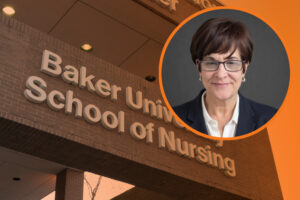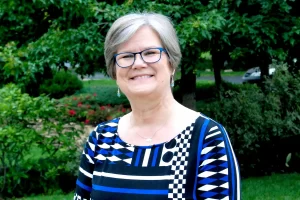The work of medical practitioners is both rewarding and challenging. No matter the roles, disciplines, and areas of practice, caring for patients, even in the best of times, leads to long and busy workdays that can take a toll emotionally and physically.
Throw in a global pandemic of a highly infectious and potentially deadly disease, one that in addition to making many people sick has forced state and local governments to impose restrictions on gatherings of people and the wearing of personal protective equipment, and well, it makes the job of health care professional all the more demanding.
The novel coronavirus—or COVID-19—has thrown the world and this country into a crisis unlike anything seen in the last century. And the nursing field, including now-practicing graduates of Baker’s School of Nursing at Stormont Vail Health in Topeka, has been thrown smack in the middle of it.
“At the very beginning of the pandemic, nobody knew what to expect,” said Chelsea Amack, ’13, a floating emergency room (ER) nurse in the Kansas City area. “At first, they beefed up staffs. Then, nobody came. Everyone stayed home; they were afraid to come out. So, they started sending staff home, started furloughs.
“Once it got safer to come out, people started swarming ERs. People had been holding off and putting things off, and now they had to get in. We hit normal for a little bit, but we’ve now surpassed it. There are all these people with chronic conditions who went without and now have to get in for treatments.”
Chelsea Amack, ’13, ER nurse
Brittni (Sayers) Dangers, ’13, ’15, a cardiology clinic nurse in the Kansas City area, concurred with Amack’s COVID timeline. She converted to telehealth appointments in March and noticed light workloads at first as people canceled scheduled appointments and procedures during the lockdown. But that just created a backlog that created a much busier work schedule as society began reopening.
“Areas like Kansas City, where we’re all spread out . . . we were able to make sure we didn’t get overwhelmed,” Dangers said. “In June, we started to transition back to in-person, seeing a set number of patients each day.”

Dangers added that she has yet to encounter a COVID-positive patient. But that doesn’t mean procedures in seeing non-COVID patients haven’t changed drastically.
“When scheduling procedures, I have to make sure patients are tested two days before,” she said. “It has been challenging, for sure. I think everyone has just had to work a little harder.”
Working with COVID patients
When the pandemic hit, Lane Koch, ’15, and his wife saw an opportunity to become travel nurses.
“I felt like we had some skills that were needed,” said Koch, who worked at University of Kansas Medical Center in its medical-surgery and medical transplant intensive care units the previous four and a half years. “We didn’t have anything holding us down, so we decided to jump in.”
The Kochs first worked for four weeks in a COVID unit in Rockville, Maryland, then were assigned in early June to a hospital in Albuquerque, New Mexico.
Koch says the work environment can vary greatly from facility to facility, and that the differences usually are based on resources and staffing. Other differences are cultural. In Albuquerque, for instance, the Kochs have spent much of their time caring for members of the Navajo Nation, which has been hit especially hard by COVID.
“A lot of it is end-of-life care,” he said. “There are Navajo rituals they can’t perform because they can’t have the bodies [of deceased family members because of the viral infection]. It’s tough watching families deal with this. It’s difficult having to update families over the phone.”
Still, even with all the challenges, Koch says working with COVID patients has been a great experience.
“We’re exposed to different organizations and doctors,” he said. “We meet people who know a lot of different things. We’re still learning about COVID and how to treat patients differently.”
The Kochs’ contract in Albuquerque runs through mid-December. “We’ll see what COVID is doing then,” he said.
Mark Foland, ’04, site medical director at the St. Luke’s Community Hospital Emergency Department, said he’s seen wide variations in the conditions of COVID patients over the past six months.
“My first patient was a gentleman who had just returned from a trip and came down with flu-like symptoms,” Foland said. “He was visibly quite ill and required admission to the hospital. He initially improved while in the hospital, only to then drastically worsen and lose his life to the virus. Since then, I have seen patients with almost no symptoms and patients requiring aggressive life-sustaining procedures just to have a chance to survive.”
Avoiding burnout
The roles of health care providers can be extremely challenging during normal times. During a global pandemic, caring for the sick can and does lead to burnout. And it’s something most, if not all, health care providers concern themselves with, especially during the age of COVID.
“Nursing is hard, and you don’t realize how hard until you’re in the thick of it,” Dangers said. “Nursing during a pandemic is all the more challenging, no matter what area you are in. Burnout is a real thing, and while nursing is an incredible job with job security, burnout can happen to any one of us.”
Indeed, Rachel (Dannon) Rigdon,’12, who is a chaplain at a pediatric hospital in the Dallas area, says she’s spent much of the last nine months working with medical staff and other frontline workers.
“They don’t teach you what to do during times of a pandemic,” Rigdon said. “If [hospital personnel and frontline workers] can’t function, they can’t care for patients and their families.”
Rachel (Dannon) Rigdon, ’12, hospital chaplain
Rigdon says much of her counseling revolves around how to handle personal aspects of life while working long hospital shifts. For example, what should employees do with children who are attending school virtually at home and how does that affect the work schedule? And how is scheduling itself affected when staffing is stretched to the limit?
However, Rigdon stresses that not everything has to be negative during these trying times. In fact, she sees positives. People have been forced to slow down their usually hectic lives, at least temporarily. Priorities have more boundaries.
“As humans, we’re brushing death more now than ever before,” she said. “But I think that’s a good thing. It causes you to figure out more how you live. We’re figuring out what’s worth having in life.”
One way Dangers has been coping with work stress is through the practice of yoga. She’s also a yoga instructor and offers a weekly class on Zoom for health care professionals.
Signs of light
Among the hard work, long hours, and heartbreaking personal losses to the pandemic, there also are stories of hope and strength.

“I was looking out the window, and I saw this older gentleman sitting in the bed of his pickup in the parking lot in a lawn chair,” said Keith Neuenswander, ’96, director of the anesthesia department at Liberty Hospital in Liberty, Missouri. “And he’s got a cooler. He’s tailgating.”
“We come to find out that his daughter is delivering his grandchild and because of COVID, he can’t come in. When his daughter delivered his grandchild, they called him. And there was so much dirt on his truck that he wrote the name of his grandchild in the dirt on the back window on his truck. He sat there all morning waiting for his grandchild.”
Keith Neuenswander, ’96, director of anesthesia
It’s those moments that health care providers cling to during times like these. There’s no knowing when the COVID-19 pandemic will end, when the uncertainty and suffering will finally recede. But those essential health care workers will continue showing up every day knowing that they can make a difference in trying to ease the pain and anxiety that comes with such an insidious disease.
“I remain confident that while the current environment has been difficult, this too shall pass,” Foland said. “By nature, human beings are the most resilient organisms on the planet.”
Amack, too, thinks her industry will survive the epidemic, even if it never completely ceases to exist. “I think there’s a new normal,” she said. “I don’t think we’ll ever get back to where we were pre-COVID, but we’ll have this new normal that we’ll learn to work with.”





